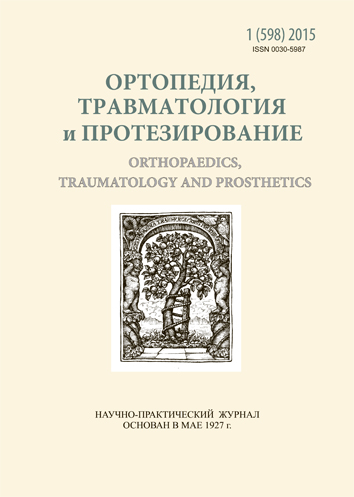Numerical modeling and analysis of the stress-strain state in the kinematic chain «lumbar spine – sacrum – pelvis»in view of the major ligaments of the sacroiliac joint
DOI:
https://doi.org/10.15674/0030-59872015134-41Keywords:
sacroiliac joint, lumbar spine, sacrum, ligamentsAbstract
Objective: To study the stress-strain state of the ligaments of the sacroiliac joint and the elements of the lumbosacral spine considering various options of the lumbar lordosis and an angle of inclination of the cranial surface of the sacrum. Methods: mathematical modeling using the finite element method. A model «lumbar spine – the sacroiliac joints – pelvis»with major ligaments (anterior sacroiliac, interosseous sacroiliac, posterior sacroiliac, sacrotuberous, sacrospinous) was built on the base of CT and MRI scans (20 and 10 patients, respectively). Results: there were revealed that anterior sacroiliac, interosseous sacroiliac, posterior sacroiliac, sacrotuberous, sacrospinous ligaments significantly restrict rotational movement in the sacroiliac joint conditions for all variants of inclination angle of the sacrum and reduce strain and movement of all the elements of «lumbar spine – sacrum – pelvis»due to load redistribution. In case of physiological angle of inclination of the sacrum and physiological lordosis there were found uniform tension stress distribution of stress in all ligaments. With increasing of loads tension stresses significantly increased in iliolumbar ligaments indicating their important role in the redistribution of stress under conditions of physiological angle of inclination of the sacrum and physiological lordosis in case of growth of the vertical load. In case of the vertical position of the sacrum and smoothed lordosis for all options of loading maximum value of tension stresses were found in the cranial and caudal part of the anterior sacroiliac ligaments and iliolumbar ligaments. A similar pattern was kept in case of increasing of load. When horizontal position of sacrum and hyperlordosis maximum value of tension stresses were found in the cranial part of the ventral and dorsal sacroiliac ligaments as well as in the iliolumbar and interosseous sacroiliac ligaments.
References
- Schwarzer A. C. The sacroiliac joint in chronic low back pain / A. C. Schwarzer, C. N. Aprill, N. Bogduk / Spine. — 1995. — Vol. 20(1). — P. 31–37.
- Maigne J. Y. Results of sacroiliac joint double block and value of sacroiliac pain provocation tests in 54 patients with low back pain / J. Y. Maigne, A. Aivaliklis, F. Pfefer / Spine. — 1996. — Vol. 21(16). — P. 1889–1892.
- The value of medical history and physical examination in diag¬nosing sacroiliac joint pain / P. Dreyfuss, M. Michaelson, K. Pau¬za [et al.] / Spine. — 1996. — Vol. 21(22). — P. 2594–2602.
- Laslett M. Diagnosing painfull sacroiliac joints: a validity study of a McKenzie evaluation and sacroiliac provocation tests / S. B. Young, C. N. Aprill, B. McDonald / Aust. J. Physiother. — 2003. — Vol. 49(2). — P. 89–97.
- Vleeming A. Mobility of the sacroilac joint in the elderly: A kinetic and radiology study / A. Vleeming, J. P. Van Wing¬erden, P. Dijkstra // Clin. Biomech. — 1991. — Vol. 6. — P. 161–168.
- Kutcenko V.A. Lumbar spondilolisthesis (pathogenesis, diagnosis, prognostication and treatment): M.P. dissertation – Kharkov, 2009.-555 p.
- Istomin A.G. Pelvic stability restoration after sacro-iliac joints injury and diseases: M.P. dissertation - Kharkov, 2001 – 309 p.
- Biomechanical analysis of reducing sacroiliac joint shear load by optimization of pelvic muscle and ligament forces / J. J. Pel, C. W. Spoor, A. L. Pool-Goudzwaard [et al.] // Ann. Biomed. Eng. — 2008. — Vol. 36(3). — P. 415–424, doi: 10.1007/s10439-007-9385-8.
- Staude V.A. Numerical simulation and analysis of the stress-strain state of sacro-iliac joint in different variants of lumbar lordisis / Staude V.A., Kondratyev A.V., Karpinsky M. Yul./ Orthopedics, Travmatology and prosthetics – 2012.- N2.- P. 50 – 56.
- Kapandzhy A.I. Spine. Joint fixation. Mechanic schemes of human body with comments. / A.I. Kapandzhy/ 6 – th edition.- M.”Aksmo”, 2009,- P. 334.
- Berezovsky V.A. Biophysical characteristics human tissues: reference book /Berezovsky V.A., Kolotilov N.N./ K.: Naukova dumka, 1990.-224 p.
- Finite element methods in spine biomechanics research / L. G. Gilbertson, V. K. Goel, W. Z. Kong, J. D. Clausen // Crit. Rev. Biomed Eng. — 1995. — Vol. 23(5–6). — P. 411–473.
- Anatomical and biomechanical analysis of the unique and consistent locations of sacral insufficiency fractures / N. J. Sinstrom, J. E. Heiserman, K. E. Kortman [et al.] / Spine. — 2009. — Vol. 34(4). — P. 309–315, doi: 10.1097/BRS.0b013e318191ea01.
- Alyamovsky A.A. Solid Works/COSMOS Works. Engineering analysis by finit element method /A.A. Alyamovsky.- M: DMK Press, 2004.- 432 p.
Downloads
How to Cite
Issue
Section
License
Copyright (c) 2015 Volodymyr Staude, Andrey Kondratyev, Mykhaylo Karpinsky

This work is licensed under a Creative Commons Attribution 4.0 International License.
The authors retain the right of authorship of their manuscript and pass the journal the right of the first publication of this article, which automatically become available from the date of publication under the terms of Creative Commons Attribution License, which allows others to freely distribute the published manuscript with mandatory linking to authors of the original research and the first publication of this one in this journal.
Authors have the right to enter into a separate supplemental agreement on the additional non-exclusive distribution of manuscript in the form in which it was published by the journal (i.e. to put work in electronic storage of an institution or publish as a part of the book) while maintaining the reference to the first publication of the manuscript in this journal.
The editorial policy of the journal allows authors and encourages manuscript accommodation online (i.e. in storage of an institution or on the personal websites) as before submission of the manuscript to the editorial office, and during its editorial processing because it contributes to productive scientific discussion and positively affects the efficiency and dynamics of the published manuscript citation (see The Effect of Open Access).














